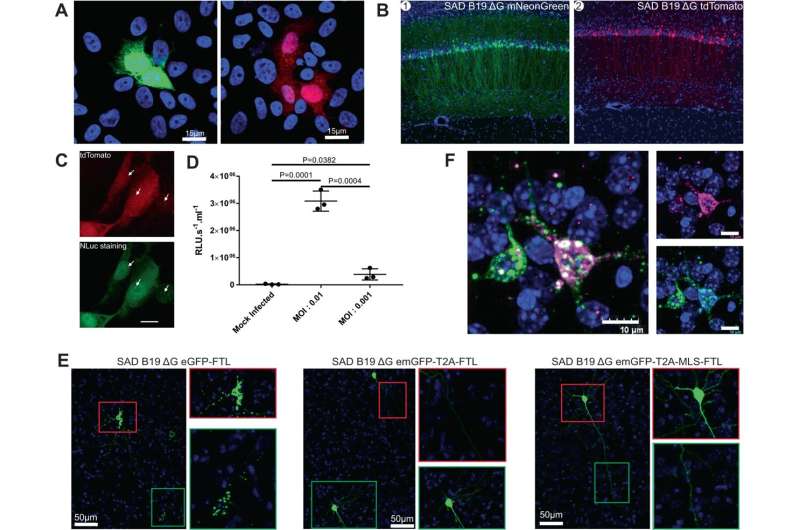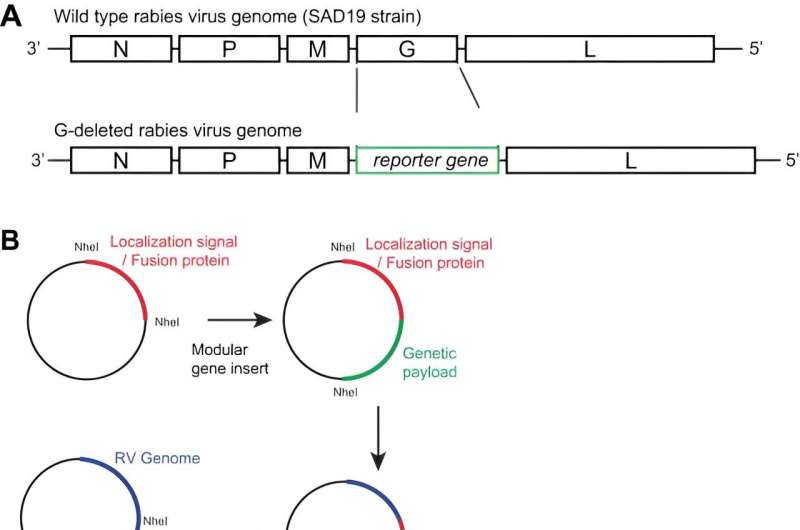This article has been reviewed according to Science X's editorial process and policies. Editors have highlighted the following attributes while ensuring the content's credibility:
fact-checked
trusted source
proofread
Research team creates novel rabies viral vectors for neural circuit mapping

A research team led by the University of California, Irvine has created 20 new recombinant rabies viral vectors for neural circuit mapping that offer a range of significant advantages over existing tools, including the ability to detect microstructural changes in models of aging and Alzheimer's disease brain neurons.
The study published today online in the journal Molecular Psychiatry, introduced proof-of-concept data demonstrating the power of these new vectors, which express a range of improved fluorescent proteins to provide expanded multi-scale multi-modal capabilities.
Naturally occurring rabies infections target the nervous system. Scientists harnessed this tendency to create engineered forms of the rabies virus that are coupled to sensors and other payloads—for example, some respond to light by turning bright green and act as tracers that map brain circuits.
"Viral genetic tools are critical for improving anatomical mapping and functional studies of cell-type-specific and circuit-specific neural networks," said Xiangmin Xu, co-corresponding author and UCI Chancellor's Professor of anatomy & neurobiology and director of the Center for Neural Circuit Mapping.
"These new variants significantly enhance the capability and reach of neural labeling and circuit mapping across microscopic and macroscopic imaging scales and modalities, including 3D light and X-ray microscopy. We will make these new tools readily available to the neuroscience community through our established service platform at the CNCM."

These new recombinant viral vectors are designed to target very specific components of neuron biology in order to analyze pathological changes that occur during Alzheimer's disease and other brain diseases. They can be targeted to specific subcellular locations and organelles, as well as live imaging of neuronal activities using calcium indicators. The team conducted imaging analysis of mouse brains to demonstrate the discovery power of these new tools.
"These cutting-edge tools hold immense potential for understanding neural circuitry in both normal and pathological conditions and offer the ability to target specific regions of the brain with precision peptides or proteins to modulate neuronal functions for targeted treatment strategies," said Bert Semler, co-corresponding author and UCI Distinguished Professor of Microbiology & Molecular Genetics.
Alexis Bouin, Ph.D. and Ginny Wu are co-first authors who led and coordinated the project. Additional team members include Orkide Koyuncu, assistant professor of microbiology & molecular genetics; Qiao Ye, graduate student; Michele Wu, Liqi Tong, Ph.D., and Lujia Chen, Ph.D., members of the Xu lab, and Todd Holmes, professor of physiology & biophysics. Leveraging the UCI Center for Neural Circuit Mapping's broad collaborative network, team members from UCSD include Keun-Young Kim, Sebastien Phan, Mason R. Mackey, Ranjan Ramachandra, and Distinguished Professor Mark H. Ellisman.
More information: Alexis Bouin et al, New rabies viral resources for multi-scale neural circuit mapping, Molecular Psychiatry (2024). DOI: 10.1038/s41380-024-02451-6





















